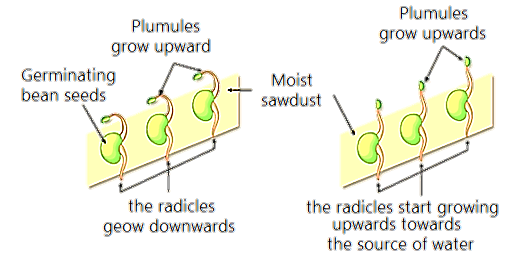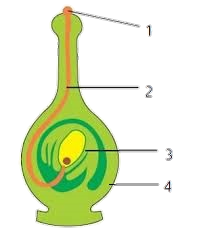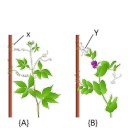ICSE Class 10 Biology Chapter 7 Selina Concise Solutions - Free PDF Download
FAQs on Concise Biology Class 10 ICSE Solutions for Chapter 7 - Chemical Coordination in Plants
1. According to selina concise biology class 10 icse solutions for chapter 7 - chemical coordination in plants, what are tropic movements, and how many types are present?
According to Selina Concise Biology Class, 10 ICSE Solutions for Chapter 7 - Chemical Coordination in Plants tropic movements mean the growth movements that occur in response to unidirectional external stimuli in a plant part. There are 5 types of tropic movements involved in the plants and can be provided as follows:
1. Phototropism: This movement is a response to the light. If there is a highly illuminating light on one side of the plant it tends to move toward that one side.
2. Geotropism: The ability to grow towards the earth. The roots are the one that shows such movements.
3. Hydrotropism: The movement of plants in response to water or moisture is called hydrotropism.
4. Thigmotropism: response of a plant towards touch is called thigmotropism.
5. Chemotropism: The growth of plants in response to chemicals from the surrounding is called chemotropism.
2. What are the subtopics covered in selina concise biology class 10 icse solutions for chapter 7 - chemical coordination in plants and how many questions are present?
There are a number of sub-topics that are covered in the Selina Concise Biology Class 10 ICSE Solutions for Chapter 7 - Chemical Coordination in Plants and can be indicated as follows:
Plant hormones
Types of plant hormones such as auxins. gibberellins, cytokinins, ethylene, abscisic acid (ABA).
Coordination in plants which also means the topic movements observed in plants.
All of these sub-topics are covered along with their respective functions. This provides an idea to the students as to how each plant has its movements and how some of them are exceptions to the movements mentioned.
3. Is selina concise biology class 10 icse solutions for chapter 7 - chemical coordination in plants one of the best solutions for class 10 icse students?
Selina Concise Biology Class 10 ICSE Solutions for Chapter 7 - Chemical Coordination in Plants includes all the important questions with solutions and detailed explanations. This detailed explanation helps students understand the reason behind each of the topics and why such things occur. This will not only clear all the doubts but will also improve the application skills required during the preparation for board exams. The detailed solutions that are provided through Vedantu will also help the students gain more knowledge regarding the topic.
4. Does selina concise biology class 10 icse solutions for chapter 7 - chemical coordination in plants help score more in exam?
At Vedantu students get training with the help of highly trained experts in Biology. This allows for a better and fast understanding of the concepts. While using the Selina Concise Biology Class 10 ICSE Solutions for Chapter 7 - Chemical Coordination in Plants also helps them prepare for exams and can also serve as a medium of self-study which in return increases the confidence level of students in themselves. The students need not go to any tuition and get their concepts cleared as they can sit at home and view all the answers to the questions that they have.
5. Does selina concise biology class 10 icse solutions for chapter 7 - chemical coordination in plants help in application-based questions?
More than just understanding the concepts for exams, Selina Concise Biology Class 10 ICSE Solutions for Chapter 7 - Chemical Coordination in Plants helps in application-based questions as it includes the answers to those questions that need to be done physically to understand the meaning. Once the students follow the guide as provided in Selina Concise Biology Class 10 ICSE Solutions for Chapter 7 - Chemical Coordination in Plants, they get to understand the concepts while they perform the experiments. This helps in further practicals during their higher classes as well.













































